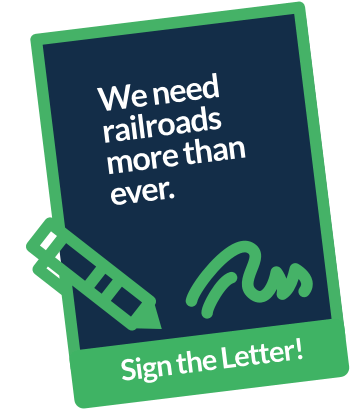The U.S. Surface Transportation Board (STB), which oversees the economic regulation of freight railroads, is considering a rule that would mandate reciprocal switching among freight railroads. They will hold a hearing on March 15-16 to examine this policy of forced access.
 Why It Matters
Why It Matters
Forced access would compromise the efficiency of the rail network and undermine service for rail customers and communities coast-to-coast when the supply chain is already facing severe challenges. Slowing train operations across a 140,000-mile network moving 1.5 million railcars at any given time would hurt the factories, farms, ports and local economies that rely on speedy and consistent rail service.
Over time, the rule would make railroads less competitive with other modes, lead to network disinvestment and shift freight from railways to publicly funded highways. Less freight rail means more local highway congestion and more greenhouse gases, as railroads today move 40% of intercity freight but account for just 1.9% of transportation-related emissions.
What Others Are Saying
Concerns about forced access are echoed by rail labor groups, passenger railroads, major intermodal shippers, and environmental groups. Both Congressional Democrats and Republicans have urged the STB to carefully consider the implications of the rule on the supply chain. State coalition letters were filed by local leaders in California, Colorado, Florida, Georgia, Illinois, Missouri, Nevada, Ohio, Pennsylvania, Texas, and Wisconsin. Here is a sample of additional recent commentary on the rule:
“While ensuring competition is vital, so too is fostering continued private railroad investments that lessen burdens on public infrastructure. Observers and past commentors on this issue note that a major change in policy could shift freight to highways, create inefficiencies, and dampen investment.” —National Association of Counties (NACo) in a Feb. 14 filing.
“On-time performance in the commuter rail space is measured in minutes, and delays due to freight train interference, especially during peak service periods, can have a cascading effect on commuter operations, and a devastating effect on the daily lives of our customers.” —Metra in a Feb. 10 filing.
“We believe that the impact of forced switching to intermodal freight transportation would most likely be: a decline in rail infrastructure; decreased network velocity; a deterioration in domestic intermodal service; and an adverse impact on intermodal’s ability to compete with over-the-road trucking.” —Intermodal Association of North America (IANA) in a Feb. 10 filing.
“Railroads would have to give a high priority to moving goods in a way that met the reciprocal switching requirements, rather than lowering costs and speeding goods to their ultimate customers. The result would be more supply chain disruptions, and higher inflation.” —Dr. Michael Mandel, chief economist and vice president of the Progressive Policy Institute, in a Feb. 11 filing.
“Should any new regulation cause new bottlenecks, which the Biden administration and the rail industry are already working together to alleviate, freight could shift to more carbon-intensive modes of transportation.” —The National Wildlife Federation, ConservAmerica, Third Way and Conservative Coalition for Climate Solutions (C3) in a Feb. 14 filing.
“Allowing other railroads to be able to switch on other railroad properties will likely add to the delays and possibly increase the probability of poor communication and confusion over prevailing operating rules.” —Dennis Pierce, president of the Brotherhood of Locomotive Engineers & Trainmen, in a Feb. 11 filing.
“Reciprocal switching may certainly be welcome by a subset of rail shippers that would like to pay less to transport their goods. But giving them the right to choose their shipper would impose a significant cost on incumbent railroads and their other customers.” —Ike Brannon, senior fellow at the Jack Kemp Foundation and former economist with the U.S. Treasury and House Energy & Commerce Committee, and Michael Gorman, Niehaus Chair in Business Analytics and Operations at the University of Dayton School of Business, in a Feb. 11 filing.
Issue Background
Reciprocal switching involves a complex and time-consuming series of rail car interchanges—a single car switch can take 68 steps and 6 days to complete. Government mandated switching would deter railroads from investing and innovating by creating uncertainty about whether a given railroad could regain its investments into infrastructure. Rail routes, after all, are designed and built in consideration of the health and operation of the entire network. Plus, voluntary reciprocal switching already occurs through private negotiations between railroads, and the STB has existing authority to order switching in the event of anticompetitive conduct.

It’s important to remember that railroads consistently stand out in logistics for their commitment to infrastructure spending—some $25 billion annually in recent years, which helped them meet supply chain challenges with resilience, moving more intermodal in the first half of 2021 than ever before. Freight demand is expected to grow 30% nationally by 2040. Especially now, as automation, e-commerce and supply chain upheaval alter the transportation landscape, it would be counterproductive to make railroads less competitive with other modes.
Take Action
Please consider signing our grassroots letter to the STB, urging them to reject the proposed rule on forced access. Before the Board’s March 15-16 hearing, we want to ensure they’ve heard from a variety of the voices who benefit from robust railroads and who would be negatively impacted by diminished rail service.



